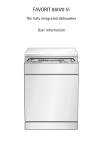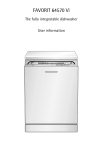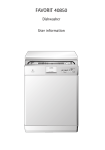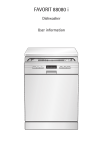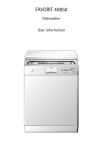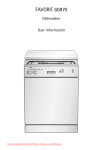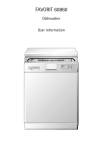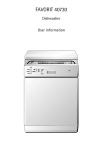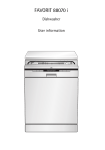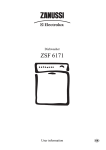Download AEG FAVORIT 65070 Vi Operating instructions
Transcript
FAVORIT 65070 Vi The fully integratable dishwasher User information Dear customer, Please read this User Information carefully and keep it to refer to at a later date. Pass this User Information on to any subsequent owner of the appliance. 1 3 2 3 2 The following symbols are used in the text: Safety instructions Warning: Notes that concern your personal safety. Attention: Notes that show how to avoid damage to the appliance. Useful tips and hints Environmental information Your dishwasher is fitted with the new “PULSE WASH” dishwashing system. With this dishwashing system the motor speed and spray pressure are varied during the dishwashing cycle to achieve better cleaning of the dishes. It is for this reason that the noise level varies during the dishwashing cycle. Contents Operating Instructions . . . . . . . . . . . . . . . . . . . . . . . . . . . . . . . . . . . . . 4 Safety . . . . . . . . . . . . . . . . . . . . . . . . . . . . . . . . . . . . . . . . . . . . . . . . . . . . . . . . . 4 Diagram of appliance . . . . . . . . . . . . . . . . . . . . . . . . . . . . . . . . . . . . . . . . . . . 5 Control panel . . . . . . . . . . . . . . . . . . . . . . . . . . . . . . . . . . . . . . . . . . . . . . . . . . 5 Prior to using for the first time . . . . . . . . . . . . . . . . . . . . . . . . . . . . . . . . . . 7 Setting the water softener . . . . . . . . . . . . . . . . . . . . . . . . . . . . . . . . . . . . . . . . 7 Adding special salt. . . . . . . . . . . . . . . . . . . . . . . . . . . . . . . . . . . . . . . . . . . . . . . 9 Filling up with rinse aid. . . . . . . . . . . . . . . . . . . . . . . . . . . . . . . . . . . . . . . . . . . 10 Activating/deactivating the acoustic signal . . . . . . . . . . . . . . . . . . . . . . . . . . 12 In daily use . . . . . . . . . . . . . . . . . . . . . . . . . . . . . . . . . . . . . . . . . . . . . . . . . . . . Loading cutlery and dishes . . . . . . . . . . . . . . . . . . . . . . . . . . . . . . . . . . . . . . . . Adjusting the height of the upper basket. . . . . . . . . . . . . . . . . . . . . . . . . . . . Adding detergent. . . . . . . . . . . . . . . . . . . . . . . . . . . . . . . . . . . . . . . . . . . . . . . . Using 3in1 detergents . . . . . . . . . . . . . . . . . . . . . . . . . . . . . . . . . . . . . . . . . . . . Selecting the dishwashing cycle (Cycle Table) . . . . . . . . . . . . . . . . . . . . . . . . Starting a dishwashing cycle . . . . . . . . . . . . . . . . . . . . . . . . . . . . . . . . . . . . . . Setting the Delay Timer. . . . . . . . . . . . . . . . . . . . . . . . . . . . . . . . . . . . . . . . . . . Switching off the dishwasher. . . . . . . . . . . . . . . . . . . . . . . . . . . . . . . . . . . . . . 13 13 16 17 18 19 20 20 21 Care and cleaning . . . . . . . . . . . . . . . . . . . . . . . . . . . . . . . . . . . . . . . . . . . . . . 22 What to do if... . . . . . . . . . . . . . . . . . . . . . . . . . . . . . . . . . . . . . . . . . . . . . . . . . 24 Remedying small malfunctions . . . . . . . . . . . . . . . . . . . . . . . . . . . . . . . . . . . . 24 If the dishwashing results are not satisfactory. . . . . . . . . . . . . . . . . . . . . . . . 26 Disposal . . . . . . . . . . . . . . . . . . . . . . . . . . . . . . . . . . . . . . . . . . . . . . . . . . . . . . . 27 Technical data. . . . . . . . . . . . . . . . . . . . . . . . . . . . . . . . . . . . . . . . . . . . . . . . . . 27 Notes for Test Institutes . . . . . . . . . . . . . . . . . . . . . . . . . . . . . . . . . . . . . . . . . 28 Installation and connection instructions. . . . . . . . . . . . . . . . . 30 Safety information for the installation. . . . . . . . . . . . . . . . . . . . . . . . . . . . 30 Installing the dishwasher . . . . . . . . . . . . . . . . . . . . . . . . . . . . . . . . . . . . . . . . 31 Connecting the dishwasher . . . . . . . . . . . . . . . . . . . . . . . . . . . . . . . . . . . . . . 32 Guarantee/Customer Service . . . . . . . . . . . . . . . . . . . . . . . . . . . . . . Service 35 . . . . . . . . . . . . . . . . . . . . . . . . . . . . . . . . . . . . . . . . . . . . . . . . . . . . . . 39 3 Operating Instructions 1 Safety Prior to using for the first time • Follow the ”Instructions for installation and connection”. Correct use • The dishwasher is only intended for washing domestic dishes. • Additions or modifications to the dishwasher are not permitted. • Use only special salt, detergent and rinse aid suitable for domestic dishwashers. • Do not put any solvents in the dishwasher. This could cause an explosion. Child safety • Keep packaging away from children. There is a risk of suffocation. • Children often do not recognise the hazards associated with electrical appliances. Don’t allow children to use the dishwasher unsupervised. • Make sure that children and pets don’t climb into the dishwasher. Could endanger life! • Dishwasher detergents can cause chemical burns to the eyes, mouth and throat. Could endanger life! Comply with the safety instructions of the dishwasher detergent manufacturer. • The water in the dishwater is not for drinking. Risk of chemical burns. General safety • Repairs to the dishwasher are only to be carried out by qualified service engineers. • When the dishwasher is not being used, switch it off and shut off the water tap. • Never unplug the appliance by pulling on the cable. Always pull the plug. • Never sit or stand on the open door. • If the dishwasher is located in a room where there may be a frost, remove the connection hose from the tap after each use of the dishwasher. 4 Diagram of appliance Top Spray Nozzle Upper basket spray arm and floor spray arm Water hardness dial Dispenser for special salt Dispenser for detergent Dispenser for rinse aid Control panel Rating plate Filters Control panel To use the appliance, always open the dishwasher door first. ON/OFF button The ON/OFF button is used to turn the dishwasher on and off. 5 Set delay timer 1 Multi-display Programme buttons 2 3 Control indicators Function buttons The Programme buttons are used to select the desired dishwashing cycle. Function buttons: In addition to the pre-set dishwashing cycle, the following functions can also be set using these buttons: Function button 1 Sets the water softener Function button 2 Activates/deactivates rinse aid inflow Function button 3 Activates/deactivates the acoustic signal The multi-display can indicate: – the level of hardness to which the water softener is set. – whether the rinse aid inflow has been activated/deactivated. – whether the acoustic signal has been activated/deactivated. – the start delay that has been set. – the estimated time remaining for the current dishwashing cycle. – what type of error has occurred with the dishwasher. The control indicators have the following meanings: 1) Refill with special salt 1) Refill with rinse aid 1) These control indicators are never illuminated while a dishwashing cycle is running. 6 Prior to using for the first time 3 1. Set the water softener 2. Fill up with special salt for water softeners 3. Fill up with rinse aid If you wish to use 3in1 detergent, do the following: – First read the section “Using 3in1 detergents”. – Fill the salt container with dishwasher salt. – Set the softener unit to its lowest setting. – Deactivate the rinse aid inflow. For dishwashers where the rinse aid inflow cannot be deactivated, set the rinse aid dosage to “I”. – Before the start of the dishwashing cycle put 3in1 detergent in the detergent dispenser. – The drying result may be affected. Setting the water softener 3 The water softener must be set manually and electronically: To avoid scale deposits on the dishes and in the dishwasher, the dishes must be washed with soft water, i.e. water with a low lime content. The water softener must be set according to the table to the water hardness in the area where you live. Your local water company will be able to give you information about the water hardness in your area. The dishwasher must be switched off. Setting manually: 1. Open the dishwasher door. 2. Remove the lower basket from the dishwasher. 3. Turn water hardness dial on the left wall of the dishwasher interior to O or 1 (see table). 7 3 Setting electronically: 1. Press the ON/OFF button. If the only LED indicator illuminated is one that belongs to a programme button, this means that this dishwashing cycle has been activated. The dishwashing cycle must be deselected: Press function buttons 2 and 3 simultaneously for approx. 2 seconds. The LED indicators of all the buttons that can be selected light up. 2. Press function buttons 2 and 3 simultaneously and keep them pressed. The LED indicators for function buttons 1 to 3 will flash. 3. Press function button 1. The LED indicator for function button 1 will flash. The multi-display will indicate the hardness setting. 4. Pressing function button 1 increases the hardness setting by 1. (Exception: hardness setting 1 follows hardness setting 10). 5. When the hardness setting is correct, press the ON/OFF button. The hardness setting is now saved. If the water softener is set electronically to “1”, this switches off the control indicator for special salt. Setting for water hardness Water hardness in °d 2) in mmol/l 3) 51 - 70 43 - 50 37 - 42 29 - 36 23 - 28 9.0 - 12.5 7.6 - 8.9 6.5 - 7.5 5.1 - 6.4 4.0 - 5.0 IV 19 - 22 15 - 18 3.3 - 3.9 2.6 - 3.2 III 11 - 14 1.9 - 2.5 II 4 - 10 0.7 - 1.8 I/II below 4 below 0.7 I Range Number Indicator of on the multiacoustic display signals1) Manual Electronic 1 10 4) 9 8 7 6 10L 9L 8L 7L 6L 10 9 8 7 6 5 4* 5L 4L 5 4 3 3L 3 2 2L 2 1 no salt required 1L 1 0* 1) The water hardness will only be indicated acoustically if the acoustic signal has been activated. 2) (°d) German degree, measure of the hardness of water 3) [mmol/l] millimol per litre, international unit for water hardness 4) On this setting the length of the dishwashing cycle may be slightly longer. *) factory setting 8 Adding special salt 3 3 To decalcify the water softener, it must be filled up with special salt. Use only special salt suitable for domestic dishwashers. If you do not use 3 in1 detergent, fill up with special salt: – Before using the dishwasher for the first time. – When the control indicator for special salt is illuminated on the control panel. 1. Open the door and remove the lower basket. 2. Screw open the lid on the salt dispenser by turning it anti-clockwise. 3. Only when using the dishwasher for the first time: Fill the salt dispenser with water. 4. Place the funnel (supplied) over the dispenser opening. Fill the dispenser with special salt; the capacity of the dispenser is approx. 1.0-1.5 kg, depending on the size of the grains. Do not overfill the dispenser. If water overflows when filling up with special salt, this is completely harmless. 5. Clean away any salt remnants from the dispenser opening. 6. Screw the lid back on in a clockwise direction. 7. Run a dishwashing cycle after filling the salt dispenser with special salt. This will wash away salt water and salt crystals that have been spilt. Depending on the size of the salt grains, it can take several hours for the salt to dissolve in the water and for the control indicator for special salt to go out. 9 Filling up with rinse aid With rinse aid the rinsing water drains away better and so you get smear-free, gleaming dishes and clear glasses. If you do not use 3in1 detergent, fill up with rinse aid: – Before using the dishwasher for the first time. – When the control indicator for rinse aid is illuminated on the control panel. Use only special rinse aid for dishwashers and no other liquid detergents. 1. Open the door. The rinse aid compartment is located on the inside of the dishwasher door. 2. Press the release button on the rinse aid compartment. 3. Open the cover. 4. Pour rinse aid in slowly right up to the broken “max” line; this corresponds to a volume of approx. 140 ml when full. 5. Press the lid shut until it clicks into place. 6. Wipe up any spilt rinse aid with a cloth. Otherwise there will be too much foam when rinsing. 10 Setting the amount of rinse aid required 3 Only change the amount dispensed, if smears, milky spots (reduce the amount) or dried on water spots (increase the amount) can be seen on glasses and dishes. (See section “If dishwashing results are not satisfactory”.) The dosage can be set from 1-6. The dosage is pre-set to “4” in the factory. 1. Open the dishwasher door. 2. Press the release button on the rinse aid compartment. 3. Open the cover. 4. Set the dosage level. 5. Press the lid shut until it clicks into place. 6. If rinse aid has leaked out, wipe it away with a cloth. Activating/deactivating the inflow of rinse aid 3 1. Press the ON/OFF button. If the only LED indicator illuminated is one that belongs to a programme button, this means that this dishwashing cycle has been activated. The dishwashing cycle must be deselected: Press function buttons 2 and 3 simultaneously for approx. 2 seconds. The LED indicators of all the buttons that can be selected light up. 2. Press function buttons 2 and 3 simultaneously and keep them pressed. The LED indicators for function buttons 1 to 3 will flash. 3. Press function button 2. The LED indicator for function button 2 will flash. The multi-display will indicate the current setting: 0d Inflow of rinse aid is deactivated 1d Inflow of rinse aid is activated (factory setting) 4. Pressing function button 2 activates and deactivates the rinse aid dispensing function. 5. Once the multi-display is indicating the required setting, press the ON/ OFF button. The setting is now saved. 11 Activating/deactivating the acoustic signal 3 In addition to the optical display (e.g. indicating the end of the cycle, errors) you can also choose to set an acoustic signal. 1. Press the ON/OFF button. If the only LED indicator illuminated is one that belongs to a programme button, this means that this dishwashing cycle has been activated. The dishwashing cycle must be deselected: Press function buttons 2 and 3 simultaneously for approx. 2 seconds. The LED indicators of all the buttons that can be selected light up. 2. Press function buttons 2 and 3 simultaneously and keep them pressed. The LED indicators for function buttons 1 to 3 will flash. 3. Press function button 3. The LED indicator for function button 3 will flash. The multi-display will indicate the current setting: 0b Acoustic signal deactivated 1b Acoustic signal activated (ex-factory setting) 4. Pressing function button 3 will change the setting. 5. Once the multi-display is indicating the required setting, press the ON/ OFF button. The setting is now saved. 12 In daily use Loading cutlery and dishes 1 Sponges, cleaning cloths and any other objects that can absorb water must not be washed in the dishwasher. Plastic and Teflon-coated dishes and pans tend to retain water droplets. These dishes and pans therefore do not dry as well as those made of china and stainless steel. For washing in the dishwasher, the following cutlery/dishes/pots and pans are not suitable: are of limited suitability: • Cutlery with wooden, horn, china or mother of pearl handles • Plastic items that are not heat resistant • Older cutlery with cement that is sensitive to temperature • Dishes or cutlery with glued parts • Pewter or copper items • Lead crystal glass • Steel items that rust • Wooden boards/platters • Items made from synthetic materials • Only wash stoneware in the dishwasher if it is specifically marked by the manufacturer as being dishwasher-safe. • Glazed patterns may fade if washed very frequently in the dishwasher. • Silver and aluminium parts have a tendency to discolour during washing. Food remains, e.g. egg white, egg yolk and mustard often cause discoloration and staining on silver. Therefore always clean food residues from silver immediately, if it is not to be washed straight after use. • Glass can become dull after a large number of washes. • Before loading the dishes, you should: – Remove the worst of the food residues. – Soak pans with burnt-on food residues. • When loading the dishes and cutlery, please note: – Dishes and cutlery must not impede the rotation of the spray arms. – Load bowls, cups, glasses, pans, etc. with the opening downwards so that water cannot collect in them – Dishes and items of cutlery must not lie inside one another or cover one another – To avoid damage to glasses, they must not touch one another – Don’t put small items (e.g. lids) in the baskets for the dishes, but in the cutlery basket, so that they can’t fall through the holes. 13 Loading cutlery 1 Warning: Sharp knives and other items of cutlery with sharp edges must be laid in the cutlery rack or in the upper basket to avoid the risk of injury. To ensure that all items of cutlery in the cutlery basket can be reached by the water, you should: 1.Place the grid insert on the cut- 2.Place forks and spoons in the lery basket cutlery basket's grid insert with their handles pointing downwards. For larger utensils, such as whisks, leave off one half of the cutlery grid. Pots, Pans, Large Plates Load larger and heavily soiled dishes and pans in the lower basket. (Max. diameter for plates 29 cm). 14 To make it easier to load larger dishes, the two plate rests on the right in the lower basket can be folded down. Cups, Glasses, Coffee Service Load smaller, fragile crockery and long, sharp cutlery in the upper basket. • Arrange items of crockery on and under the folding cup racks so that they are offset from each other and water can reach all items. • The cup racks can be folded up out of the way for tall crockery items. • Lay or hang wine and brandy glasses in the slots in the cup racks. 15 Adjusting the height of the upper basket Maximum height of dishes in the 3 Upper basket Lower basket with upper basket raised 22 cm 30 cm with upper basket lowered 24 cm 29 cm The height of the baskets can also be adjusted when they are loaded. Raising/lowering the upper basket 1. Pull out the upper basket completely. 2. Raise the upper basket as far as it will go and then lower it vertically. The upper basket will latch into the lower or the upper position. 16 Adding detergent 1 Detergents remove the dirt from dishes and cutlery. The detergent must be added before the cycle starts. Only use detergent intended for domestic dishwashers. The detergent compartment is located on the inside of the door. 1. If the lid is closed: Press the release button. The lid will spring open. 3 2. Place the detergent in the detergent dispenser. The markings indicate the dosing levels for powder detergents: “20/30” corresponds to approx. 20/30 ml of detergent. Follow the manufacturer’s instructions with regard to dosing and storage. 3. Close the lid and press until it locks into place. In the case of very heavily soiled dishes, fill the adjoining compartment (1) with additional detergent. This detergent comes into use during the pre-wash cycle. 17 Concentrated detergents 2 Today’s detergents for dishwashers are almost exclusively low-alkaline concentrated detergents with natural enzymes in tablet or powder form. Using 50°C dishwashing cycles in conjunction with these concentrated detergents reduces pollution and is good for your dishes, as these dishwashing cycles are specially matched to the dirt-dissolving properties of the enzymes in concentrated detergents. It is for this reason that using 50 °C dishwashing cycles in conjunction with concentrated detergents can achieve the same cleaning results that can otherwise only be achieved using 65 °C cycles. Detergent tablets 3 Detergent tablets from different manufacturers dissolve at different rates. For this reason, some detergent tablets do not attain their full cleaning power during short cycles. Therefore please use dishwashing cycles with pre-wash when using detergent tablets. Using 3in1 detergents These products are detergents with a combined cleaning, rinsing and salt function. 1. Check whether these detergents are suitable for your water hardness. Follow the manufacturer’s instructions. 2. Place detergent just in the detergent dispenser. 3 If you use 3 in1 detergent, it may come about because of the different quality standards in the detergent, that the dishes do not dry sufficiently. If so, proceed as follows (see section “Adding rinse aid”): • Fill up the dispenser (if this is empty) with rinse aid. • Set rinse aid dosage to “2” mechanically. • Activate rinse aid inflow. If you want to stop using 3in1 products, please do the following: • Fill up the dispensers for salt and rinse aid again. • Switch the water softener to the highest setting and perform up to three normal cycles without loading any dishes. • Then set the water softener to the water hardness in your area. 18 Selecting the dishwashing cycle (Cycle Table) normally soiled, dried-on food remains • 1 • to • 2x • 30 MIN (60°) 4) Dishes, exclud- just used, lightly to ing saucepans normally soiled - • - • - ECO 50° 5) Dinner service and cookware, normally soiled temperaturesensitive crockery • • • • • 0,95 - 1,05 13 - 15 • - - - - < 0,1 4 Water (litres) Dinner service and cookware 6) All types of dishes Used dishes that are being stored in the dishwasher and are to be washed later. 13 - 25 9 1,0 - 1,5 0,8 90 - 110 30 23 - 25 AUTO (50°- 65°) 3) 130 - 160 Energy (kWh) • 1,8 - 2,0 • 2x • 120 - 130 • Drying heavily soiled, dried-on food remains, in particular protein and starch Final rinse Dinner service and cookware Rinse INTENSIV CARE 70° 2) 12 Type of soiling Main wash Suitable for: Pre-wash Dishwashingcycle Consumptionvalues1) Length (minutes) Programme sequence 1) The consumption values were obtained under standardised conditions. They depend on how full the baskets for the dishes are. Variations are therefore possible in practice. 2) During the final rinse, the temperature is increased to 68° for 10 minutes to disinfect e.g. babies’ bottles. 3) When using this cycle the degree of water clouding determines the amount of soiling on the dishes. The length of the cycle and water and energy consumption can vary greatly – depending upon the load and how dirty the dishes are. Depending upon the soiling, the temperature of the water will be automatically adjusted to between 50°C and 65°C. 4) When using this cycle, only load the dishwasher half full. 5) Test programme for Test Institutes 6) This cycle does not need any detergent. 19 Starting a dishwashing cycle 3 1. Check that the spray arms can turn freely. 2. Turn the water tap on fully. 3. Press the ON/OFF button. 4. Select the desired cycle. The programme indicator comes on. The remaining time expected for the cycle will be shown in the multi-display. During the dishwashing cycle, the remaining time shown in the multidisplay may be adjusted according to the size of the load, degree of soiling, etc. Interrupting or aborting a dishwashing cycle Only interrupt a dishwashing cycle that is in progress if it is absolutely necessary. 1 Interrupting the dishwashing programme by opening the dishwasher door Hot steam may escape when the door is opened. There is a risk of scalding. 1. Open the door carefully. The dishwashing cycle will stop. 2. Close the door. The cycle will continue. Aborting the dishwashing cycle 1. Press function buttons 2 and 3 and keep them pressed. The LED indicators of all the buttons that can be selected light up. Exception: The 3in1 button will only illuminate if the function has been activated. 2. Release the function buttons. The dishwashing cycle has been cancelled. 3. If you want to start a new cycle, check whether there is any detergent in the dispenser. 4. Switch off using the ON/OFF button. Setting the Delay Timer 3 20 With the delay timer you can delay the start of a dishwashing cycle for between 1 and 19 hours. 1. Press the Delay Timer button repeatedly until the multi-display shows the desired time delay, for example 12h, if the cycle is to start in 12 hours. The Delay Timer indicator is illuminated. 2. Select dishwashing cycle. 3. The time remaining to the start of the cycle is continuously displayed (e. g. 12h, 11h, 10h, … 1h etc.). To change the time delay: As long as the cycle has not yet started, you can still change the setting by pressing the DELAY TIMER button. Cancelling the time delay: Press the Delay Timer button repeatedly until the length of the selected cycle appears in the multi-display. The selected dishwashing cycle will begin immediately. To change a dishwashing cycle As long as the cycle has not yet started, you can still change the dishwashing cycle. First abort the dishwashing cycle, then re-set the time delay, lastly select the new dishwashing cycle. Switching off the dishwasher 1 If the acoustic signal has been enabled, a continuous tone will sound for approx. 15 seconds at the end of the dishwashing cycle. If the dishwasher door is not opened, the acoustic signal will repeat after 3 minutes and again after 6 minutes. Carefully open the door. Hot steam may escape. Hot dishes are sensitive to knocks. Therefore leave the dishes to cool for about 15 minutes before removing them. You also get a better drying result. 1. Press the ON/OFF button. All display indicators will go out. 2. Turn off the water tap. Removing the dishes 3 It is normal for the inner door and the dispensers to be damp. • Empty the lower basket first, then the upper basket. This way you avoid dripping water from the upper basket onto dishes in the lower basket. 21 Care and cleaning 1 Do not use furniture care products or aggressive cleaners. • When necessary, clean the dishwasher’s controls with a soft cloth and clean warm water. • Occasionally check the internal dispensers, door seal and water inlet filter (if fitted) for dirt and clean them, if necessary. Cleaning the filters 3 The filters must be regularly checked and cleaned. Dirty filters will spoil the wash results. 1. Open the door and remove the lower basket. 2. Turn the handle about ¼ of a turn anticlockwise (A) and remove the filter system (B). 3. Grasp the grip hole on the fine filter (1) and remove it from the micro-filter (2). 4. Clean all filters thoroughly under running water. 22 5. Remove the flat filter (3) from the base of the washing compartment and clean both surfaces thoroughly. 6. Re-insert the flat filter. 7. Place the fine filter in the micro-filter and fit the two together. 8. Insert the filter system in place and lock it by turning the handle clockwise as far as it will go. Ensure that the flat filter does not protrude above the base of the washing compartment. 1 Under no circumstances may the dishwasher be used without its filters. 23 What to do if... Remedying small malfunctions If the acoustic signal is activated, warning tones sound if there are faults. If one of the following fault codes is displayed in the multi-display during operation: – Fault codeÅ 10 (Problems with water inlet), – Fault codeÅ 20 (Problems with water drainage), please have a look at the following table. When the fault is remedied, press the button for the cycle that has started. The cycle will continue. With other fault codes (“Å ” followed by a number): – Abort the dishwashing cycle. – Switch the appliance off and on again. – Re-set the dishwashing cycle. If the fault is displayed again, please contact the Customer Care Department and inform them of the fault code. Malfunction 1 short warning tone continuously repeated can be heard, the cycle indicator for the selected dishwashing cycle is flashing: fault code Å 10 is displayed in the multi-display: (Problems with water inlet) Possible cause Remedy Water tap is blocked with limescale or faulty. Check the water tap and have it repaired if necessary. The tap is turned off. Turn the tap on. The filter (where present) in Clean the filter in the the threaded hose fitting threaded hose fitting. on the tap is blocked. Filters in the base of the dishwasher compartment are blocked. Press the button for the commenced dishwashing cycle; then abort the dishwashing cycle (see section: Starting a dishwashing cycle); clean filters (see section: Cleaning the filters). Water inlet hose Check the position of the has not been correctly posihose. tioned. 24 Malfunction 2 short warning tones continuously repeated can be heard. The cycle indicator for the selected dishwashing cycle is flashing, fault code Å 20 is displayed in the multi-display. (Problems with water outflow) Possible cause The sink outlet is blocked. Clean out sink outlet. Water drain hose Check the position of the has not been correctly posihose. tioned. 3 short warning tones continuously repeated can be heard, The anti-flood system has Fault code Å 30 is disbeen triggered. played in the multi-display. The mains plug is not plugged in. The cycle is not starting. Remedy First shut off the water tap, then switch off the appliance and contact the Customer Care Department. Plug in mains plug. A fuse in the house’s wiring Replace fuse. system is defective. For dishwasher models with If the dishes are to be a delay start timer: washed immediately, cancel A start time has been sethe delay start. lected. The dishwashing compartment is made from rustfree stainless steel. Rust spots in the dishwashing compartment are due to Rust spots are visible in Only wash cutlery, dishes rust particles from external the dishwashing compartand pans that are suitable sources (rust particles from ment. for dishwasher use. water pipes, pans, cutlery, etc.). Remove such spots with a commercially-available cleaning product for stainless steel. A whistling noise can be The whistling is not a cause Use a different brand of deheard when washing dishfor concern. tergent. es. 25 If the dishwashing results are not satisfactory The dishes are still dirty. • The wrong dishwashing cycle was selected. • The dishes were loaded is such a way that the dishwashing water did not reach all items. The baskets for the dishes must not be overloaded. • The filters in the base of the washing compartment are dirty or incorrectly positioned. • Good quality detergent was not used, or too little was used. • In the case of scale deposits on the dishes: The special salt dispenser is empty or the water softening system has been incorrectly set. • The drain hose is incorrectly positioned. The dishes do not dry and are not shining. • Poor quality rinse aid was used. • The rinse aid dispenser is empty. There are smears, streaks, milky spots or a shiny bluish coating on glasses and dishes. • Lower rinse aid dosage. There are dried water drops on the glasses and dishes. • Increase rinse aid dosage. • The detergent may be the cause. Contact the detergent manufacturer's customer advice centre. Glass corrosion • Contact the detergent manufacturer's customer advice centre. 26 Disposal 2 2 1 Packaging material The packaging materials are environmentally friendly and can be recycled. The plastic components are identified by markings, e.g. >PE<, >PS<, etc. Please dispose of the packaging materials in the appropriate container at the community waste disposal facilities. Old appliance Please dispose of your old appliance in line with the guidelines for disposal in your community. Warning! When your appliance has finished its working life, remove the plug from the socket. Cut off the cable and plug and dispose of them. Break the door lock so that the door no longer shuts. This prevents children from trapping themselves inside and endangering their lives. Technical data Capacity: 12 place settings including serving dishes Permitted water pressure: 1-10 bar (=10-100 N/cm2 = 0.1-1.0 MPa) Electrical connection: 230 V, 10 A, also see the rating plate on the right-hand side of the dishwasher’s interior door . Dishwashers that can be fully integrated 5 Dimensions: 820 - 880 x 596 x 546 (H x W x D in mm) Max. weight: 50 kg This appliance conforms with the following EU Directives: – 73/23/EEC dated 19.02.1973 Low Voltage Directive – 89/336/EEC dated 03.05.1989 EMC Directive inclusive of Amending Directive 92/31/EEC – 93/68/EEC dated 22.07.1993 CE Marking Directive 27 Notes for Test Institutes Testing in accordance with EN 60704 must be carried out with the appliance fully loaded and using the test cycle (see “Cycle Table”). Tests in accordance with EN 50242 must be carried out when the salt dispenser in the water softener and the rinse aid dispenser have been filled with salt and rinse aid respectively, and using the test cycle (see “Cycle Table”). Full load: 12 place settings including serving dishes Half load: 6 place settings including serving dishes, leaving alternate positions in the rack free Amount of detergent required: 5g + 25g (Type B) 20g (Type B) Rinse aid setting: 4 (Type III) 4 (Type III) Sample loading arrangements: Upper basket *) *) If necessary, move the cup rack from right to left. When doing this, ensure that the cup rack is at the same height. 28 Lower basket with cutlery basket Cutlery basket 29 Installation and connection instructions 1 Safety information for the installation • Only transport the dishwasher in an upright position, otherwise salt water may run out. • Before using the dishwasher for the first time, check for any damage caused in transport. Do not under any circumstances connect an appliance that is damaged. In the case of damage, please contact your supplier. • Never use the dishwasher if the mains cable, water inlet or drain hose are damaged; or if the control panel, work top or plinth area are damaged such that the inside of the appliance is freely accessible. • Always plug the mains plug into a correctly installed shockproof socket. • Permanent connection: a permanent connection must only be installed by a trained electrician. • Prior to using the appliance for the first time, ensure that the rated voltage and type of supply on the rating plate match that of the supply where the appliance is to be installed. The fuse rating is also to be found on the rating plate. • Multi-way plugs / connectors and extension cables must not be used. This could constitute a fire hazard through overheating. • The dishwasher’s cable must only be replaced by the Customer Care Department or a registered electrician. • A water inlet hose with safety valve must only be replaced by the Customer Care Department. 30 Installing the dishwasher • The dishwasher must be installed on a firm floor and adjusted to ensure that it is stable and level in all directions. • To compensate for unevenness in the floor and to match the height of the appliance to that of surrounding units, extend the threaded feet using a screwdriver. • The drain hose, inlet hose and mains cable must be laid so that they are able to move freely within the plinth area, and so that they are not kinked or crushed when the dishwasher is in position. • The dishwasher must also be screwed tightly to the work surface or to the adjoining units. This is essential to ensure the dishwasher does not tip up. Dishwashers that can be fully integrated 3 (see installation template supplied) The door of the appliance can be fitted with a wooden door/cupboard door with the following dimensions: Width: 591 mm – 594 mm Depth: 16 mm – 24 mm Height: max. 715 mm Weight: max. 10 kg Using the installation template supplied split cupboard doors can be easily installed and firmly fitted. 31 Connecting the dishwasher Connecting to the water supply • The dishwasher can be connected to cold and hot water supplies up to max. 60°C. • The dishwasher must not be connected to open hot water appliances or instantaneous water heaters. Permitted water pressure Lowest permitted water pressure: 1 bar (=10 N/cm2 =100 kPa) Consult your plumber if the water pressure is less than 1 bar. Highest permitted water pressure: 10 bar (=100 N/cm2 =1 MPa) If the water pressure is greater than 10 bar, a pressure reduction valve must be used (available from your dealer). Connecting the inlet hose 1 3 32 The water inlet hose must not be kinked, crushed or entangled when it is being connected. Connect the threaded hose fitting (ISO 228-1:2000) on the water inlet hose to a tap with an external thread (¾ inch). The inlet hose is fitted with either a plastic or a metal nut: – Only tighten the plastic nut hand tight. – You must tighten the metal nut using a tool. Then do a visual check for water tightness (make sure that the tap is not dripping). So that access to the tap in the kitchen is not restricted by the use of the dishwasher, we recommend installing an additional tap, or fitting a T-branch to the existing tap. If you need a longer water inlet hose than that supplied, the following VDE-approved complete hose sets are to be used. These are available from your local dealer. – Hose kit “WRflex 100” (Code: 911 239 034) – Hose kit “WRflex 200” (Code: 911 239 035) Water drainage 1 Drain hose The drain hose must not be kinked, crushed or entangled. Connecting the drain hose: – Maximum permitted height: 1 metre. – Minimum required height: 40 cm above the bottom edge of the appliance. Extension hoses • Extension hoses are available from your dealer or from our Customer Care Department. To ensure that the function of the appliance is not impeded, the internal diameter of extension hoses must be 19 mm. • Extension hoses must not be laid more than a maximum distance of 3 metres horizontally; the maximum permitted height for the connection for the drain hose is then 85 cm. Sink outlet connection • The outlet of the drain hose (ø 19 mm) fits all commonly available sink outlet types. The outer diameter of the sink outlet connection must be at least 15 mm. • The drain hose must be fixed to the sink outlet connection using the hose clamp supplied. Water drainage if the dishwasher is built-in at high level If the dishwasher is installed at a high level, and the drain hose connection is less than 30 cm from the lower edge of the appliance, adapter kit ET 111099520 must be fitted by the Customer Care Department. Anti-flood system For protection from water damage, the dishwasher is equipped with a anti-flood system. In the event of a fault, the safety valve in the water inlet hose immediately interrupts the supply of water to the appliance and the drain pump is activated. In this way water can neither escape nor overflow. The remaining water in the appliance is automatically pumped out. Should a fault occur when the appliance is switched on, a buzzing tone can also be heard. 33 Electrical connection Details about the voltage, type of supply and the fuses required are to be found on the rating plate. The rating plate is located on the righthand inner edge of the dishwasher door. To isolate the dishwasher from the mains, pull out the mains plug. Important: – The plug must be accessible after the appliance has been installed. – Following installation, live parts and insulated wiring must not be accessible to a test finger in accordance with DIN EN 60335-1. Connecting systems The water inlet hose, drain hose and the mains cable must all be connected to the side of the dishwasher as there is no space for them behind the appliance. 2 connection pieces 45° or straight, outer ø 19 mm, length 30 mm waterinlet 34 mains cable doublevalve watermains socket drainage waterdrainage waterinlet mains cable Guarantee/Customer Service Weitere Kundendienststellen im Ausland In diesen Ländern gelten die Garantiebedingungen der örtlichen Partner. Diese können dort eingesehen werden. Further after-sales service agencies overseas In these countries our AEG agents’ own guarantee conditions are applicable. Please obtain further details direct. Autres agences étrangères assurant le service après-vente Dans ces pays, les conditions de garantie des concessionnaires de la région sont valables. Vous pouvez les consulter sur place. Otros puntos de Postventa en el extranjero En estos países rigen las condiciones de nuestros representantes locales. las cuales pueden ser consultadas allí mismo. Ulteriori uffici del servizio tecnico assistenza clienti all’estero In questi paesi sono valide le condizioni di garanzia dei partner locali. Queste condizioni possono essere esaminante sul luogo. Serviços de assistência técnica no estrangeiro Nestes países são válidas as condições de garantia dos concessionários locais, podendo aí ser consultadas. További vevöszolgálati irodák külföldön Ezekben az országokban a mi AEG vevöszolgálatainknál saját jótállási feltételek alkalmazhatók. A további adatokat kérjük közvetlenül szerezzék be. Servisne službe Na garancijskem listu boste našli seznam pooblašèenih servisnih služb AEG. U.A.E. Abu Dhabi Universal Trading Company P.O. Box 43 99 Tel.: 335331 Jordan Jordan Household Supply Co. Ltd. P.O. Box 3/68 Amman/Tel.: 69 70 50 Malta ITC International Trading Company White House Building Mountbatte Street Blata L-Bajda/Tel.: 220644 Egypt Middle East Commercial Center P.O. Box 19 Kairo-Heliopolis Tel.: 29917/31634 Canada EURO-LINE Appliances 2150 Winston PARK Drive 20 Oakville, Ontario L6H 5V1 Tel.: 905 829 3980 Fax: 905 829 3985 Mauritius Happy World Centre Ltd. P.O. 7 54 1 Chausee Street Port Louis Tel.: 25355 35 36 Australia ANDI-Co Pty. Ltd 9 Kingston Town Close Oakleigh VIC 3166 Tel.: (03) 9569 1235 Fax: (03) 9569 1450 Korea (South) Core Incorp. 3/F Chewoo Bldg. 200 Nonhyun-Dong Kangnam-Ku Seoul Telefon 82 2 549 89 61 Namibia AEG NAMIBIA (PTY) LIMITED-Jeppe Street Northern Industrial Area Windhoek Tel.: (061) 21-6082/4 Fax: (061) 217838 Bahrain/Arabian Gulf A.A. Zayani & Sons P.O. Box 9 32 Bahrain Tel.: 261060 Croatia Electrolux D.O.O. Suplova 7 10000 Zagreb Tel.: 1 61 19512 Fax: 1 61 19513 New Zealand Euro-Life New Zealand Ltd. Privat Bag 58 Symonds Street Auckland Tel.: (09) 525 2222 Bulgaria Electrolux Bulgaria E.O.O.D. 91 Levski Blvd. 1000 Sofia Tel.: 2 806676 Fax. 2 980 5276 Kuwait/Arabian Gulf Ali Al-Ghanim Est. P.O. Box 10 83 Tel.: 5322463 Fax: 5242114 Nouvelle Caledonie Socometra N.C. B.P. 483 Nouman Tel.: 275444 Cyprus Hadjikyrlakos & Sons Ltd. Prodromou 121 P.O. Box 21587 Nicosia 1511 Service Telephones: Nicosia 02 481226 Limassol 05 562182 Larnaca 04 633929 Paphos 06 932 699 Lebanon Adib & Assaferi P.O. Box 539 Tripoli Oman Moshin Haider Darwish P.O. Box 1 35 Muscat Tel.: 703743 Estonia Electrolux Estonia Ltd. Mustamäe tee 24 EE0006 Tallinn Tel.: (372) 6 650 090 Fax: (372) 6 650 092 Latavia Electrolux Latavia Ltd. Terlaton Street 42/44 1011 Riga Tel.: 371 2 297821 Fax: 371 2 821286 Poland Electrolux Poland Sp. zo.o. ul. Domaniewska 41 02-034 Warszawa tel.: 022 874 33 33 fax: 022 874 33 00 Hongkong Wo Kee Services Ltd. 585-609 Castle Peak Road Kwai Chung N.T. Hongkong Tel.: 2494 4000 Lthuania Electrolux Lthuania Verkui 29 2600 Vilnus Tel.: 372 272 3326 Fax: 372 272 3366 Russia Electrolux Russia Ltd. 16 Olympiysky prospekt 129090 Moscow Tel.: (095) 937 7837 Fax: (095) 926 5513 Israel Electricity & Electronic Services-Evis LTD. 19 Hataasia st. Raanana, Industrial area 43654 Tel: 972-9-7448118 Fax: 972-9-7603618 e-mail:[email protected] Malaysia Arzbergh Engineering No. 49A/B, Jalan Petaling Utama 7 4600 Petaling Jaya Tel.: 3 795 1084 Fax: 3 795 1082 Saudi Arabia Alia Trading Corporation P.O. Box 4101 King Abdul Aziz Street Riyadh Tel.: 4645977 Al Nahas Est. Musaidia Market I P.O. Box 1 15 29 Jeddah Tel.: 6606852 Japan Electrolux Japan Ltd. Domestic Appliances Department Maruzen Showa Warehouse Building Tookai 4-5-12, Ota-ku 143-006 Tokyo Tel.: 0120-13-7117 Fax: 03-3790-5257 Singapore Arzbergh Engineering 19 Tanglin Road 06-07 Singapore 247909 Tel.: 65 7356572 Fax: 7351124 Slovenia Electrolux Slovenia D.O.O. Traska Ul. 132 1000 Ljubljana Tel.: 61 1234 137 Fax: 61 1234 238 Thailand OLYMPIA Thai Ltd. 44 Ratchadapisek Road 10320 Bangkok Tel.: 2 513 6111 Fax: 2 513 2574 Slovakia Rep. Electrolux Slovakia S.R.O. Seberiniho 1 821 03 Bratislava Tel.: 02 4333 4322, 4355 Fax: 02 4333 6976 South Africa AEG (Pty) Ltd. 55, 12th Road P.O. Box 1 02 64 Kew/Johannesburg 2000 Tel.: 8069111 Hungary Electrolux Lehel KFT Erzsébet Királyné útja 87. 1142 Budapest Tel.: 00361/467-3200 Syria Masri & Shami P.O. Box 24 96 Damascus Tel.: 214080 37 38 Service In the event of technical faults, please first check whether you can remedy the problem yourself with the help of the operating instructions (section “What to do if…”). If you were not able to remedy the problem yourself, please contact the Customer Care Department or one of our service partners. In order to be able to assist you quickly, we require the following information: – Model description – Product number (PNC) – Serial number (S No.) (for numbers see rating plate) – Type of fault – Any error messages displayed by the appliance So that you have the necessary reference numbers from your appliance at hand, we recommend that you write them in here: Model description: ..................................... PNC: ..................................... S No: ..................................... 39 From the Electrolux Group. The world´s No.1 choice. The Electrolux Group is the world´s largest producer of powered appliances for kitchen, cleaning and outdoor use. More than 55 million Electrolux Group products (such as refrigerators, cookers, washing machines, vacuum cleaners, chain saws and lawn mowers) are sold each year to a value of approx. USD 14 billion in more than 150 countries around the world. AEG Hausgeräte GmbH Postfach 1036 D-90327 Nürnberg http://www.aeg.hausgeraete.de © Copyright by AEG 822 612 143-00-110504-01 Subject to change without notice








































